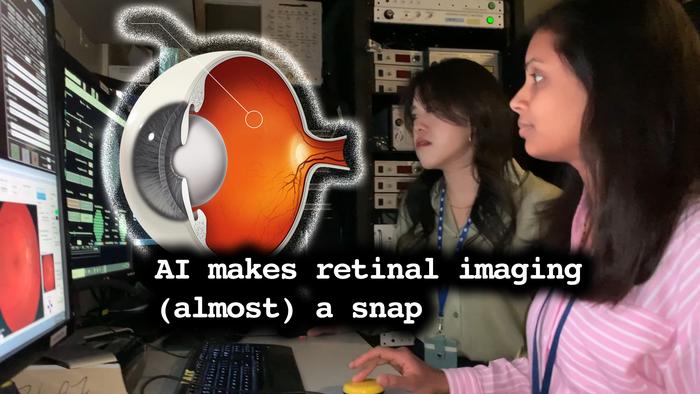Researchers at the National Institutes of Health applied artificial intelligence (AI) to a technique that produces high-resolution images of cells in the eye. They report that with AI, imaging is 100 times faster and improves image contrast 3.5-fold. The advance, they say, will provide researchers with a better tool to evaluate age-related macular degeneration (AMD) and other retinal diseases.

Credit: National Eye Institute
Researchers at the National Institutes of Health applied artificial intelligence (AI) to a technique that produces high-resolution images of cells in the eye. They report that with AI, imaging is 100 times faster and improves image contrast 3.5-fold. The advance, they say, will provide researchers with a better tool to evaluate age-related macular degeneration (AMD) and other retinal diseases.
“Artificial intelligence helps overcome a key limitation of imaging cells in the retina, which is time,” said Johnny Tam, Ph.D., who leads the Clinical and Translational Imaging Section at NIH’s National Eye Institute.
Tam is developing a technology called adaptive optics (AO) to improve imaging devices based on optical coherence tomography (OCT). Like ultrasound, OCT is noninvasive, quick, painless, and standard equipment in most eye clinics.
Imaging RPE cells with AO-OCT comes with new challenges, including a phenomenon called speckle. Speckle interferes with AO-OCT the way clouds interfere with aerial photography. At any given moment, parts of the image may be obscured. Managing speckle is somewhat similar to managing cloud cover. Researchers repeatedly image cells over a long period of time. As time passes, the speckle shifts, which allows different parts of the cells to become visible. The scientists then undertake the laborious and time-consuming task of piecing together many images to create an image of the RPE cells that’s speckle-free.
Tam and his team developed a novel AI-based method called parallel discriminator generative adverbial network (P-GAN)—a deep learning algorithm. By feeding the P-GAN network nearly 6,000 manually analyzed AO-OCT-acquired images of human RPE, each paired with its corresponding speckled original, the team trained the network to identify and recover speckle-obscured cellular features.
When tested on new images, P-GAN successfully de-speckled the RPE images, recovering cellular details. With one image capture, it generated results comparable to the manual method, which required the acquisition and averaging of 120 images. With a variety of objective performance metrics that assess things like cell shape and structure, P-GAN outperformed other AI techniques. Vineeta Das, Ph.D., a postdoctoral fellow in the Clinical and Translational Imaging Section at NEI, estimates that P-GAN reduced imaging acquisition and processing time by about 100-fold. P-GAN also yielded greater contrast, about 3.5 greater than before.
“Adaptive optics takes OCT-based imaging to the next level,” said Tam. “It’s like moving from a balcony seat to a front row seat to image the retina. With AO, we can reveal 3D retinal structures at cellular-scale resolution, enabling us to zoom in on very early signs of disease.”
While adding AO to OCT provides a much better view of cells, processing AO-OCT images after they’ve been captured takes much longer than OCT without AO.
Tam’s latest work targets the retinal pigment epithelium (RPE), a layer of tissue behind the light-sensing retina that supports the metabolically active retinal neurons, including the photoreceptors. The retina lines the back of the eye and captures, processes, and converts the light that enters the front of the eye into signals that it then transmits through the optic nerve to the brain. Scientists are interested in the RPE because many diseases of the retina occur when the RPE breaks down.
By integrating AI with AO-OCT, Tam believes that a major obstacle for routine clinical imaging using AO-OCT has been overcome, especially for diseases that affect the RPE, which has traditionally been difficult to image.
“Our results suggest that AI can fundamentally change how images are captured,” said Tam. “Our P-GAN artificial intelligence will make AO imaging more accessible for routine clinical applications and for studies aimed at understanding the structure, function, and pathophysiology of blinding retinal diseases. Thinking about AI as a part of the overall imaging system, as opposed to a tool that is only applied after images have been captured, is a paradigm shift for the field of AI.”
More news from the NEI Clinical and Translational Imaging Section.
Reference:
Vineeta Das, Furu Zhang, Andrew Bower, et al. Revealing speckle obscured living human retinal cells with artificial intelligence assisted adaptive optics optical coherence tomography. Communications Medicine. April 10, 2024, https://doi.org/10.1038/s43856-024-00483-1.
This press release describes a basic research finding. Basic research increases our understanding of human behavior and biology, which is foundational to advancing new and better ways to prevent, diagnose, and treat disease. Science is an unpredictable and incremental process— each research advance builds on past discoveries, often in unexpected ways. Most clinical advances would not be possible without the knowledge of fundamental basic research. To learn more about basic research, visit https://www.nih.gov/news-events/basic-research-digital-media-kit.
NEI leads the federal government’s efforts to eliminate vision loss and improve quality of life through vision research…driving innovation, fostering collaboration, expanding the vision workforce, and educating the public and key stakeholders. NEI supports basic and clinical science programs to develop sight-saving treatments and to broaden opportunities for people with vision impairment. For more information, visit https://www.nei.nih.gov.
About the National Institutes of Health (NIH): NIH, the nation’s medical research agency, includes 27 Institutes and Centers and is a component of the U.S. Department of Health and Human Services. NIH is the primary federal agency conducting and supporting basic, clinical, and translational medical research, and is investigating the causes, treatments, and cures for both common and rare diseases. For more information about NIH and its programs, visit https://www.nih.gov/.
NIH…Turning Discovery Into Health®
Journal
Communications Medicine
DOI
10.1038/s43856-024-00483-1
Method of Research
Experimental study
Subject of Research
People
Article Title
Revealing speckle obscured living human retinal cells with artificial intelligence assisted adaptive optics optical coherence tomography
Article Publication Date
10-Apr-2024




